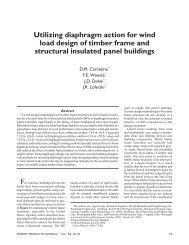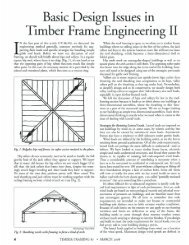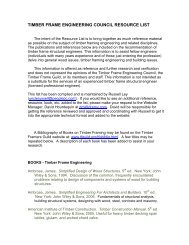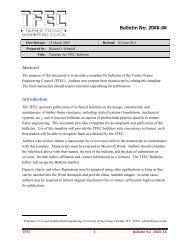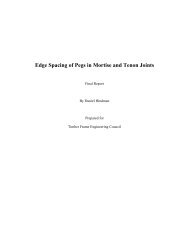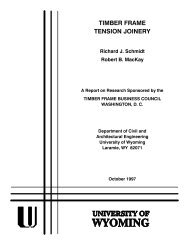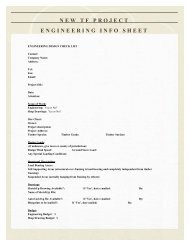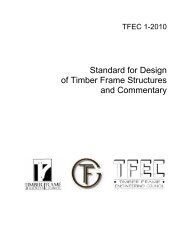Load Duration and Seasoning Effects on Mortise & Tennon Joinery
Load Duration and Seasoning Effects on Mortise & Tennon Joinery
Load Duration and Seasoning Effects on Mortise & Tennon Joinery
You also want an ePaper? Increase the reach of your titles
YUMPU automatically turns print PDFs into web optimized ePapers that Google loves.
digits. This drop of moisture c<strong>on</strong>tent can have the obvious effect of shrinkage. The<br />
effects <strong>on</strong> joint strength <str<strong>on</strong>g>and</str<strong>on</strong>g> stiffness are investigated in this research.<br />
The investigati<strong>on</strong> included three different load levels <str<strong>on</strong>g>and</str<strong>on</strong>g> four different species of<br />
wood. The load levels were zero load for the c<strong>on</strong>trol group, <str<strong>on</strong>g>and</str<strong>on</strong>g> 1000 lb <str<strong>on</strong>g>and</str<strong>on</strong>g> 2000 lb.<br />
The magnitude of the l<strong>on</strong>g-term load was determined by the strength of the short-term<br />
tests c<strong>on</strong>ducted in this research <str<strong>on</strong>g>and</str<strong>on</strong>g> by Schmidt <str<strong>on</strong>g>and</str<strong>on</strong>g> Daniels (1999). The joints were not<br />
kept in a special c<strong>on</strong>diti<strong>on</strong>ing chamber, but rather they were allowed to seas<strong>on</strong> in an<br />
envir<strong>on</strong>ment in which both the temperature <str<strong>on</strong>g>and</str<strong>on</strong>g> humidity were subject to variati<strong>on</strong>.<br />
Short-term joint tests to failure were c<strong>on</strong>ducted <strong>on</strong> all of the joints after the interval of<br />
sustained load <str<strong>on</strong>g>and</str<strong>on</strong>g> seas<strong>on</strong>ing was c<strong>on</strong>cluded. A short-term test procedure similar to that<br />
of the eastern white pine joint tests was used.<br />
4.1.1. Test Frame Set-up<br />
To test the effects of load durati<strong>on</strong> <strong>on</strong> mortise <str<strong>on</strong>g>and</str<strong>on</strong>g> ten<strong>on</strong> joints, a l<strong>on</strong>g-term load test<br />
frame was designed. A test frame was c<strong>on</strong>structed to utilize a coil spring that could be<br />
adjusted to maintain a desired load. The load frame held two joints at the same time,<br />
each joint pulling against the other. Figure 4-1 shows the test frame with two joint<br />
specimens. Two-inch diameter schedule 40 pipe was used to hold the two joints apart.<br />
The pipes were c<strong>on</strong>nected to the joints with floor flanges that were bolted to the ends of<br />
the mortise member.<br />
The spring was c<strong>on</strong>tained within a piece of four-inch square tubing, three inches l<strong>on</strong>g.<br />
Side plates were welded to the sides of the square tubing. The side plates had a dual<br />
purpose. The first was structural <str<strong>on</strong>g>and</str<strong>on</strong>g> allowed c<strong>on</strong>necti<strong>on</strong> to the ten<strong>on</strong> of <strong>on</strong>e of the test<br />
joints. The sec<strong>on</strong>d purpose was to serve as a surface for calibrati<strong>on</strong> markings. Locati<strong>on</strong>s<br />
33




